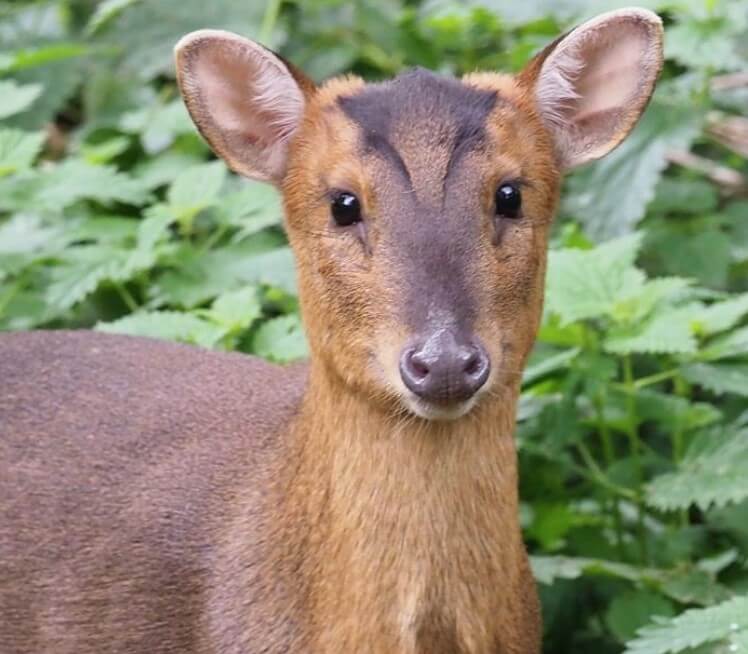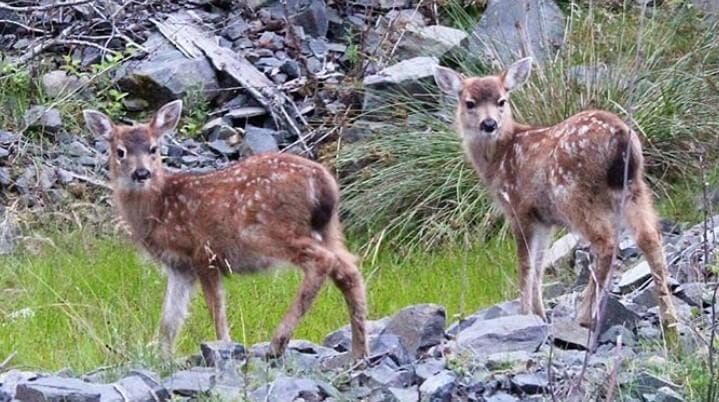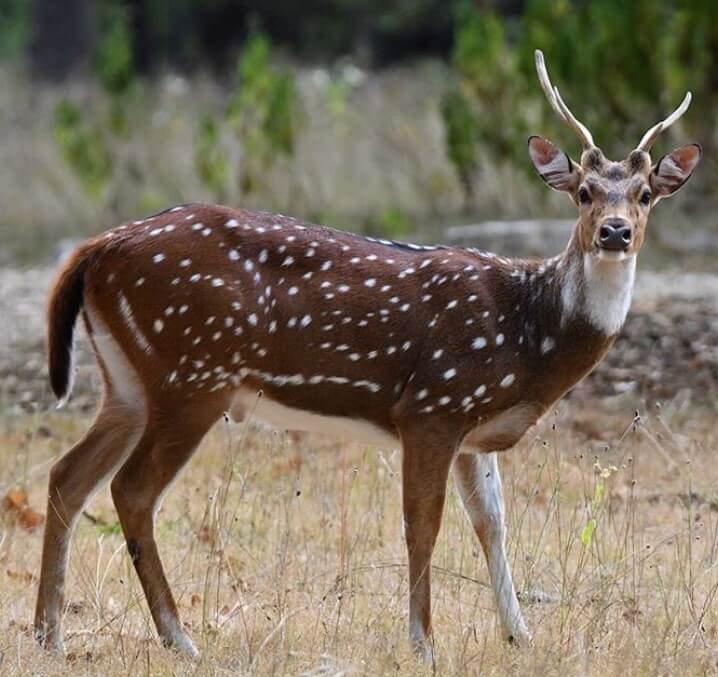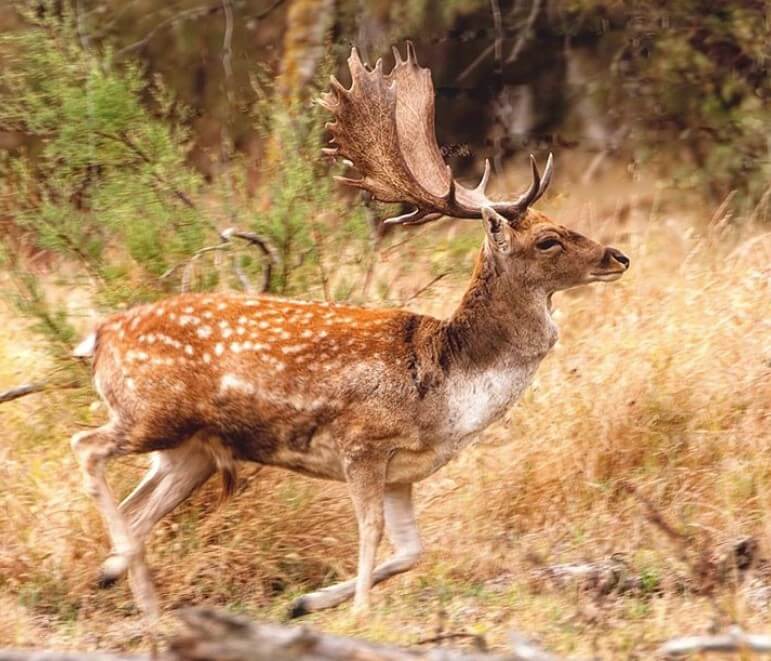For many, deer are graceful creatures glimpsed fleetingly in fields or forests. But did you know some captivating deer species can become cherished companions in the right setting?
This might come as a surprise, but with proper care and responsible ownership, certain deer species can thrive in well-maintained environments.
From the miniature Muntjac to the majestic Axis Deer, these unique animals offer an unforgettable connection with the natural world.
However, it’s crucial to remember that deer are not domesticated animals.
They require specialized care and ample space to roam.
So, before you get starry-eyed imagining a spotted fawn frolicking in your backyard, buckle up as we explore six fascinating deer species that, with the right commitment, could become part of your extraordinary pet family.
6 Deer Species You Can Keep as Pets
1. Muntjac Deer
The ability of this species to attain the same size as a dog makes it a top six species to be considered when considering deer as pets.
Expert breeders opine that the Muntjac deer are clean, well-behaved, as well as compact enough to be raised within the house.
These deer possess fangs that protrude, and these fangs are canine teeth.
These teeth are used to destroy furniture and carpets, which may bring about incurring unnecessary financial expenses.
Hence you should raise the deer in a room devoid of these things if you want them indoors.
They also possess a gland on their head, which is sensitive to touch. It is known as a scent gland.
They, however, warn that they should be raised outside the house. The most suitable manner of raising them, however, is to do so using a litter box.
These species of deer are known to produce little or no odor and are known to be very affectionate.
Reeves’s Muntjac is the most common species you should consider. Also, the Leaf Muntjac deer is suitable as well because of its size.
Pros and Cons of Muntjac Deer
Pros:
- Size: Muntjac deer are small, making them suitable for indoor living in a well-ventilated space or a large outdoor enclosure.
- House training: Muntjac deer are easily house-trained, and their waste products do not smell much.
- Low maintenance: They do not need to be walked and do not jump on furniture.
- Affectionate: They can become very familiar and enjoy playing games with their owners.
- Hardy: Muntjac deer are generally healthy and hardy animals, with few specific health concerns.
- Trainable: They can be trained to use a cat door and can be thought to learn their own name and come when called.
Cons:
- Special requirements: Muntjac deer have specific needs, such as a suitable bed that should be cleaned regularly but always left with something smelling like the deer.
- Age: It is recommended to buy a Muntjac deer that is at least five days old and has been bottle-fed for a couple of days.
- Litter box: You will need to clean the litter box and change the substrate every four days.
- Price: Muntjac deer can be found for around 500 USD, but prices may vary depending on the subspecies and age of the deer.
- Breeding: Muntjac deer have no breeding season and can enter rut any time of the year, which can make them aggressive toward other males and anything else in their territory.
2. Sitka Deer
A group of Dutch researchers conducted research using ninety mammal species for the suitability of pets.
This research was conducted as a way of responding to a 2013 Dutch national animal welfare policy.
The study disclosed that the Sitka deer are the most suitable for pets after dogs, cats, and other popular pets.
The reason for this may be as a result of its calm nature.
Other advantages include a life span of 25 years, the presence of spots well into adulthood, the ability to socialize, etc.
If you are one of those who travel a lot for tourism and for the sake of relaxation, the Nara park in Japan is famous for its habitation of Sitka deer.
These deer roam freely in that park and are genial with humans.
If you choose this species of deer, you will need to devote a lot of attention to them as they need a lot of attention in other to socialize.
Pros and Cons of Sitka Deer
Pros:
- Native to the Pacific Northwest: Sitka deer are well-adapted to the region’s climate and environment, making them suitable for hunting in their natural habitat.
- Beautiful appearance: Sitka deer have a striking appearance with their black-tailed and white-spotted coat, which can make them an attractive target for hunters.
- Plentiful population: Sitka deer have a large and stable population, which makes them a reliable hunting target.
- Versatile hunting: Sitka deer can be hunted using various methods, such as bow hunting, rifle hunting, and muzzleloader hunting, providing a variety of hunting experiences.
- Excellent food source: Sitka deer are a nutritious and delicious source of meat, which can be enjoyed by hunters and their families.
Cons:
- Wild nature: Sitka deer are wild animals and may not be suitable as pets due to their natural instincts and behaviors.
- Hunting regulations: Hunting Sitka deer is subject to various regulations and licenses, which may vary by state and region.
- Limited availability: Sitka deer are not widely available for sale as pets, as they are primarily hunted for their meat and are not considered domesticated animals.
- Habitat destruction: Overhunting or habitat destruction can negatively impact the population of Sitka deer, which may affect their availability as a hunting target in the future.
- Ethical considerations: Some people may argue that hunting Sitka deer is unethical or unnecessary, as they are a wild species with a natural role in the ecosystem.
3. Reindeer
These species are also called Caribou. These species are, however, the only species known to have been domesticated. History has it that the Reindeer is traditionally hunted for its meat, hides, milk, and serves as a means of conveyance for some people.
If you opt for this species of deer, ensure you feed it with lichens during winters, as they possess the enzyme Lichenase which can digest lichen.
The Reindeer was in the 19th century semi-domesticated by the United Staes Revenue Cutter Service in the state of Alaska as a source of livelihood for its people.
Pros and Cons of Reindeer
Pros:
- Meat and milk: Reindeer provide a source of meat and milk, which can be used for food and other products.
- Hides and fur: Reindeer hides and fur can be used for clothing, blankets, and footwear.
- Antlers: Reindeer antlers have various uses, such as tools, weapons, and ornaments.
- Domesticated: Reindeer can be domesticated and used for meat, milk, tallow, and hides.
- Resilient: Reindeer are resilient animals that can live in harsh environments, such as the Arctic Circle.
Cons:
- Mosquitoes: Reindeer are susceptible to mosquito bites, which can cause stress and lead to reduced feeding.
- Predators: Reindeer have predators, such as wolves and bears, which can pose a threat to their survival.
- Habitat: Reindeer require a specific habitat with suitable vegetation and conditions, which may limit their availability for domestication.
- Caribou confusion: Reindeer and caribou are often confused, which can lead to misunderstandings about their suitability as pets or mounts.
- Special care: Reindeer require specialized care and attention, which may not be suitable for all individuals.
4. Axis Deer
These deer are spotted deer that are known to originate from India.
They are referred to as Chital by a section of the public; others, however, refer to them as spotted deer.
They feed mostly on grasses and are found in Texas, United States.
The Axis deer were introduced into Molokai, Maui, and Lanai areas of the Hawaiian island to increase its hunting population, which has brought a level of destruction to its environment.
They are capable of resisting disease and do not require inoculations or deworming.
Pros and Cons of Axis Deer
Pros:
- Diet: Axis deer can gain nutrients from grass, which gives them an advantage in areas with limited vegetation.
- Fawn production: Axis deer can produce significantly more fawns than whitetail deer due to their shorter gestation period and quicker breeding cycle.
- Meat quality: Axis deer meat is described as clean and non-gamey, with less intramuscular fat than other deer species.
- Habitat adaptation: Axis deer can thrive in various habitats, including tropical and subtropical regions.
Cons:
- Invasive species: Axis deer have been known to become invasive in some areas, causing damage to ecosystems and agriculture.
- Population growth: Axis deer have a high reproductive rate, which can lead to overpopulation and negative impacts on native species.
- Impact on native species: Axis deer can outcompete native species for resources, reducing their availability and impacting their populations.
- Habitat destruction: Axis deer can cause damage to habitats by overgrazing and trampling vegetation.
- Conflict with humans: Axis deer can cause damage to crops and gardens, as well as pose a threat to public health.
5. Fallow Deer
These deer originate from western Eurasia. They have characteristics including being spotted, sexually dimorphic, etc.
They are capable of adapting to domestication. History has it that they have been known to be domesticated as early as the 9th century B.C.
These species of deer, instead of being kept in the house, are placed in zoos, estates, and parks.
Some places do not impose regulations on this species owing to their lack of ability to breed with other species of deer.
They have a life span of between 15-25 years, the ability to jump as high as 7 feet. Hence, it is advisable to raise your fence as high as 8 feet, they cannot transmit chronic diseases, etc.
You should also consider raising these deer on pastures that can support other ungulates that are commonly kept if you are considering the Fallow deer.
The renewable crop of antler velvet, which is popular in the Asian market, is derived from the Fallow species of deer.
Pros and Cons of Fallow Deer
Pros:
- Meat quality: Fallow deer meat is considered to be of high quality, with a mild flavor and tender texture.
- Versatile: Fallow deer can be used for various purposes, such as meat, antler production, and breeding.
- Adaptability: Fallow deer are adaptable to different environments and can thrive in a variety of habitats.
- Economic value: Fallow deer can be a source of income for farmers and landowners through hunting, breeding, and meat production.
- Cultural significance: Fallow deer have cultural and historical significance in many countries, including the UK, where they were introduced for hunting purposes.
Cons:
- Escape and damage: Fallow deer can escape from enclosures and cause damage to crops and gardens, which can lead to conflicts with farmers and landowners.
- Competition with native species: Fallow deer can compete with native species for resources, which can have negative impacts on local ecosystems.
- Disease transmission: Fallow deer can transmit diseases to other deer species and livestock, which can be a concern for wildlife managers and farmers.
- Cost of management: Managing fallow deer populations can be costly, as it requires resources for feeding, breeding, and disease control.
- Habitat destruction: Fallow deer can damage habitats by overgrazing and trampling vegetation, which can have long-term consequences for the ecosystem.
6. White-Tailed Deer
These deer are kept for their meat and are mostly found in many localities in the United States. Although these species of deer are illegal to be kept as pets, they can be very tame and also make fantastic pets.
A lot of situations have arisen where orphaned fawns are found and successfully raised by farmers, but the authorities then confiscate these deer. These fawns often stray away from their habitats when the mother white-tailed deer leave in search of food.
These species of deer, however, are notorious for causing car collisions, and because they are known to be agile, they can scale fences and destroy gardens and ornaments.
Until the laws regarding the domestication of this species of deer are revised and changed, you should consider other species available.
Pros and Cons of White-Tailed Deer
Pros:
- Hunting and wildlife management: White-tailed deer are a significant game species, providing opportunities for hunting and wildlife management.
- Aesthetic and cultural value: These deer are valued for their beauty and cultural significance, often found in parks, gardens, and suburban areas.
- Economic benefits: White-tailed deer contribute to the economy through hunting, ecological benefits, and potential amenity value.
- Ecosystem impact: At appropriate densities, white-tailed deer can help maintain biodiversity and encourage new plant growth.
Cons:
- Impact on human health and safety: High populations of white-tailed deer can pose risks to human health through deer-vehicle collisions and tick-borne illnesses.
- Negative interactions with humans: White-tailed deer are often perceived as nuisance animals due to their negative interactions with humans, particularly in densely populated areas.
- Damage to agriculture and property: These deer can cause damage to crops, gardens, and private property.
- Overpopulation: White-tailed deer populations can become overpopulated, leading to negative impacts on forest health and other native wildlife.
- Ecological concerns: Overpopulation can cause imbalances in ecosystems, leading to a decrease in plant diversity and other negative ecological impacts.
Legality of Owning a Deer
The legality of owning a deer varies significantly depending on several factors, including your location, local regulations, and the specific circumstances surrounding the ownership of the deer.
| State | Legal Status | Additional Notes |
| Arkansas |
Legal with proper permits
|
|
| Colorado |
Legal with proper permits
|
|
| New Hampshire |
Legal with proper permits
|
|
| Vermont |
Legal with proper permits
|
|
| South Dakota |
Legal with proper permits
|
|
| Alabama | Legal with special regulations |
Captured by hand before July 2012
|
| Idaho | Legal with special regulations |
Special permitting required
|
| Florida | Legal with special regulations |
Special permits required
|
| Kansas | Legal with special regulations |
Special permits required
|
| Michigan | Legal with special regulations |
Special permits required
|
| Mississippi | Legal with special regulations |
Special permits required
|
| Missouri | Legal with special regulations |
Special permits required
|
| New Jersey | Legal with special regulations |
Special permits required
|
| North Dakota | Legal with special regulations |
Special permits required
|
| Oregon | Legal with special regulations |
Special permits required
|
| Wisconsin | Legal with special regulations |
Special permits required
|
| New York | Not allowed | |
| North Carolina | Not allowed | |
| Pennsylvania | Not allowed | |
| Rhode Island | Not allowed | |
| South Carolina | Not allowed | |
| West Virginia | Not allowed | |
| Wyoming | Not allowed | |
| Arizona | No specific laws | |
| Connecticut | No specific laws | |
| Delaware | No specific laws | |
| Hawaii | No specific laws | |
| Illinois | No specific laws | |
| Indiana | No specific laws | |
| Iowa | No specific laws | |
| Kentucky | No specific laws | |
| Louisiana | No specific laws | |
| Maryland | No specific laws | |
| Massachusetts | No specific laws | |
| Minnesota | No specific laws | |
| Montana | No specific laws | |
| Nebraska | No specific laws | |
| Nevada | No specific laws | |
| Ohio | No specific laws | |
| Oklahoma | No specific laws | |
| Utah | No specific laws | |
| Virginia | No specific laws | |
| Washington | No specific laws |
Final Thoughts
While these miniature and unique deer species offer undeniable charm, remember, they’re not cuddly house pets.
Owning a deer requires a significant commitment – ample space, specialized care, and a deep understanding of their wild instincts.
Research local regulations and consult experienced breeders before welcoming a deer into your life.








GIPHY App Key not set. Please check settings